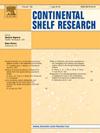Wave climate at Babitonga Bay using hybrid downscaling
IF 2.2
3区 地球科学
Q2 OCEANOGRAPHY
引用次数: 0
Abstract
This study presents a comprehensive analysis of the wave climate in Babitonga Bay, Brazil, using a hybrid downscaling approach. By integrating dynamic and statistical techniques, we effectively transferred CAWCR oceanic wave reanalysis data (1979 to 2022), for a point on the continental shelf to the coastal region, focusing on the ports of São Francisco do Sul and Itapoá. The methodology included selecting representative sea states, propagating them with the SWAN wave model, and reconstructing the time series using radial basis function interpolation. Validation against observational data at three ADCP stations showed that the hybrid downscaling results more accurately captured wave parameters compared to CAWCR hindcast, particularly at shallow water stations (4–7 m depth) where the downscaled significant wave heights closely tracked measured values, highlighting the effectiveness of the downscaling approach. Furthermore, the analysis reveals a bimodal wave climate at each port, distinguishing between the persistent, operational wave conditions and less frequent but distinct swell events from a secondary direction, a critical insight for risk assessment. The study provides detailed 2D and 3D analyses of wave parameters such as significant wave height (), peak period (), and wave direction, revealing crucial insights into wave age and height dynamics in São Francisco do Sul. These findings offer valuable data for coastal management and infrastructure planning in Babitonga Bay and similar regions. The hybrid downscaling methodology presented here proves to be an efficient and reliable tool for characterizing wave climate in port regions, providing essential information for safe navigation and port operations in São Francisco do Sul and Itapoá.
巴比通加湾的波浪气候使用混合降尺度
本研究采用混合降尺度方法对巴西Babitonga湾的波浪气候进行了综合分析。通过整合动力和统计技术,我们有效地将大陆架上某点的CAWCR海浪再分析数据(1979 - 2022)转移到沿海地区,重点是南奥弗朗西斯科港和伊塔波港。方法包括选择代表性海况,利用SWAN波浪模型传播海况,利用径向基函数插值重建时间序列。对三个ADCP站观测数据的验证表明,与CAWCR后播相比,混合降尺度结果更准确地捕获了波浪参数,特别是在浅水站(4-7 m深度),降尺度的有效波高与实测值密切相关,突出了降尺度方法的有效性。此外,分析还揭示了每个港口的双峰波气候,区分了持续的、可操作的波浪条件和次要方向上不太频繁但明显的涌浪事件,这是风险评估的关键见解。该研究提供了详细的二维和三维波浪参数分析,如有效波高(Hs)、峰值周期(Tp)和波浪方向,揭示了南弗朗西斯科岛波浪年龄和高度动力学的重要见解。这些发现为Babitonga湾和类似地区的海岸管理和基础设施规划提供了有价值的数据。本文提出的混合降尺度方法被证明是表征港口地区波浪气候的有效和可靠的工具,为南奥弗朗西斯科和伊塔波的安全航行和港口作业提供了必要的信息。
本文章由计算机程序翻译,如有差异,请以英文原文为准。
求助全文
约1分钟内获得全文
求助全文
来源期刊

Continental Shelf Research
地学-海洋学
CiteScore
4.30
自引率
4.30%
发文量
136
审稿时长
6.1 months
期刊介绍:
Continental Shelf Research publishes articles dealing with the biological, chemical, geological and physical oceanography of the shallow marine environment, from coastal and estuarine waters out to the shelf break. The continental shelf is a critical environment within the land-ocean continuum, and many processes, functions and problems in the continental shelf are driven by terrestrial inputs transported through the rivers and estuaries to the coastal and continental shelf areas. Manuscripts that deal with these topics must make a clear link to the continental shelf. Examples of research areas include:
Physical sedimentology and geomorphology
Geochemistry of the coastal ocean (inorganic and organic)
Marine environment and anthropogenic effects
Interaction of physical dynamics with natural and manmade shoreline features
Benthic, phytoplankton and zooplankton ecology
Coastal water and sediment quality, and ecosystem health
Benthic-pelagic coupling (physical and biogeochemical)
Interactions between physical dynamics (waves, currents, mixing, etc.) and biogeochemical cycles
Estuarine, coastal and shelf sea modelling and process studies.
 求助内容:
求助内容: 应助结果提醒方式:
应助结果提醒方式:


